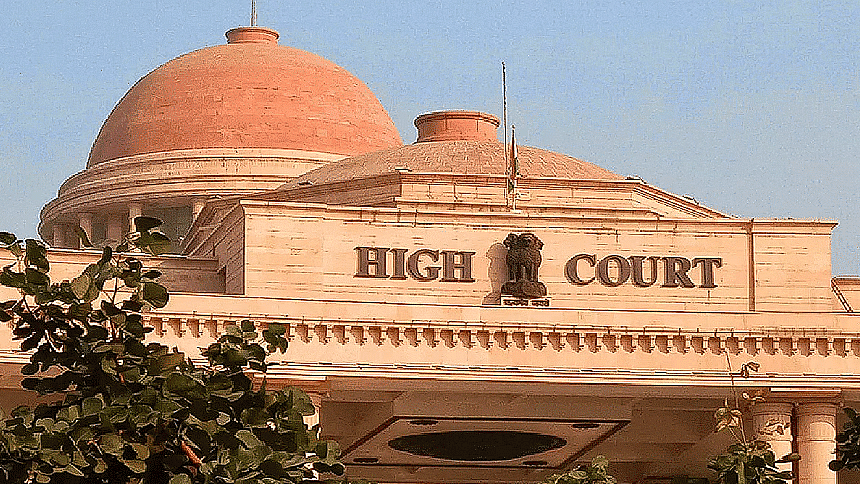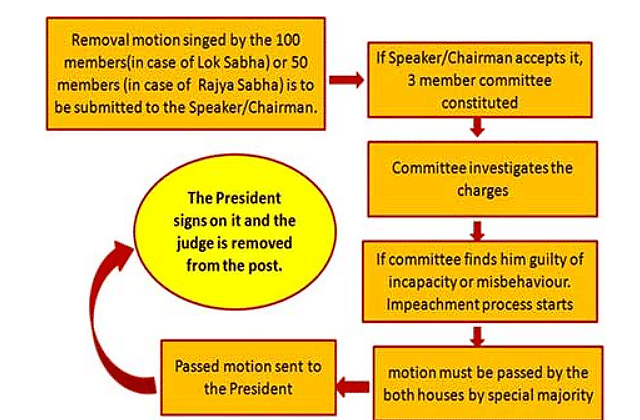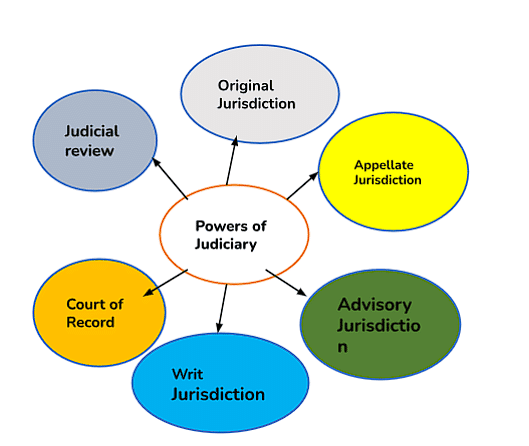Laxmikanth Summary: High Court | Indian Polity for UPSC CSE PDF Download
| Table of contents |

|
| Composition and Appointment |

|
| Qualifications, Oath, and Salaries |

|
| Tenure, Removal, and Transfer |

|
| Independence of the High Court |

|
| Jurisdiction and Powers of High Court |

|
In India, there is a judicial system that includes the Supreme Court, high courts, and subordinate courts. The high court is positioned above subordinate courts but below the Supreme Court. Each state has its own high court, and the high court is the top authority in the state's judicial administration.
The concept of high courts in India started in 1862 when they were established in Calcutta, Bombay, and Madras. Later, more high courts were set up in different provinces. After 1950, each state got its own high court as per the Constitution.
 High Court
High Court
In 1956, a change allowed the Parliament to create a common high court for two or more states. Currently, there are 25 high courts in India. Delhi has its own high court, while Jammu and Kashmir and Ladakh share one. The other union territories come under the jurisdiction of various state high courts.
The Constitution, specifically Articles 214 to 231 in Part VI, provides details about how high courts are organized, their independence, jurisdiction, powers, and procedures.
Composition and Appointment
The composition and appointment process of a high court involve a chief justice and judges appointed by the President. The Constitution does not specify the court's size, leaving it to the President's discretion.
Appointment of Judges
- Judges of a high court are appointed by the President.
- The Chief Justice is appointed by the President in consultation with the Chief Justice of India and the respective state's governor.
- Other judges are appointed after consulting the Chief Justice of the concerned high court.
- For a common high court covering multiple states, the President consults with the governors of all relevant states.
Consultation Process
- The Second Judges Case (1993) ruled that high court judge appointments must align with the Chief Justice of India's opinion.
- The Third Judges Case (1998) stated that, for high court appointments, the Chief Justice of India should consult a collegium of the two most senior Supreme Court judges.
- Sole opinion of the Chief Justice of India is not sufficient for the 'consultation' process.
Changes and Challenges
- The 99th Constitutional Amendment Act and the National Judicial Appointments Commission Act of 2014 introduced the National Judicial Appointments Commission (NJAC).
- However, the Supreme Court in 2015 declared both the 99th Constitutional Amendment and the NJAC Act unconstitutional, reverting to the previous collegium system.
- The Court expressed concerns that the new system (NJAC) could compromise judicial independence
Fourth Judges Case (2015):
- In the Fourth Judges Case (2015), the Supreme Court emphasized that the NJAC system would jeopardize the judiciary's independence.
- The Court invalidated both the 99th Constitutional Amendment and the NJAC Act, reinstating the collegium system.
Qualifications, Oath, and Salaries
Qualifications of Judges
- Citizenship: The individual must be a citizen of India.
- Judicial Experience:
(a) The person should have held a judicial office in the territory of India for ten years.
(b) The person should have been an advocate of a high court (or high courts in succession) for ten years.
Note: Unlike the Supreme Court, there is no prescribed minimum age for appointment, and there is no provision for appointing a distinguished jurist as a high court judge.
Oath or Affirmation
Before commencing their duties, an individual chosen for the position of a high court judge is required to take an oath or affirm their commitment before the state governor or a designated authority. The oath includes:
- Faith and allegiance to the Constitution of India.
- Upholding the sovereignty and integrity of India.
- Faithful and impartial performance of duties without fear or favor.
- Upholding the Constitution and the laws.
Salaries
The salaries, allowances, privileges, leave, and pension of high court judges are determined by Parliament. These cannot be varied to their disadvantage after the appointment, except during a financial emergency. As of 2018:
- Chief Justice's salary increased from ₹90,000 to ₹2.50 lakh per month.
- Judge's salary increased from ₹80,000 to ₹2.25 lakh per month.
- Judges also receive sumptuary allowances and facilities such as free accommodation, medical, car, telephone, etc.
Tenure, Removal, and Transfer
Tenure of Judges
- A judge remains in office until reaching the age of 62. Any disputes about their age are resolved by the President after consulting with the Chief Justice of India, and the President's decision is final.
- Judges have the option to resign by submitting a written letter to the President.
- Removal from office can occur if recommended by Parliament and approved by the President.
- Judges cease to hold office if appointed to the Supreme Court or transferred to another high court.
Removal of Judges
A judge of a high court can only be removed from office through a process called impeachment. Impeachment involves a specific set of steps that need to be followed. The grounds for removal are either proven misbehavior or incapacity.

The process is regulated by the Judges Enquiry Act of 1968 and includes the following steps:
- A removal motion, signed by 100 members (for Lok Sabha) or 50 members (for Rajya Sabha), is submitted to the Speaker/Chairman.
- The Speaker/Chairman decides whether to admit or reject the motion.
- If admitted, a three-member committee is formed to investigate the charges, consisting of the chief justice or a Supreme Court judge, the chief justice of a high court, and a distinguished jurist.
- If the committee finds the judge guilty of misbehavior or incapacity, the motion is considered by each House of Parliament with a special majority.
- After both Houses pass the motion, an address is presented to the President for the judge's removal.
- The President issues the final order for removal.
Transfer of Judges
The President has the authority to transfer judges between high courts, with consultation from the Chief Justice of India. Upon transfer, the judge receives additional compensatory allowances determined by Parliament.
- A 1977 Supreme Court ruling emphasized that judge transfers should be exceptional and in the public interest, not punitive.
- Judicial review is necessary to prevent arbitrary transfers, and only the transferred judge can challenge the decision.
Third Judges Case (1998)
- In high court judge transfers, the Chief Justice of India must consult the Supreme Court collegium and the chief justices of both the sending and receiving high courts.
- The sole opinion of the Chief Justice of India does not constitute the entire consultation process
Acting and Additional judges
Additional Judges:
- The President can appoint qualified individuals as additional judges of a high court for a temporary period, not exceeding two years.
- This appointment can occur when there is a temporary increase in the high court's workload or a backlog of cases.
Acting Judges:
- The President can also appoint a qualified person as an acting judge of a high court in specific situations.
- This includes instances where a regular judge (excluding the chief justice) cannot perform duties due to absence or other reasons or is appointed temporarily as the chief justice.
- An acting judge serves until the permanent judge resumes duty.
- However, both additional and acting judges cannot continue in office after reaching the age of 62 years.
Retired Judges:
- The chief justice of a state's high court can ask a retired judge, either from that high court or another, to serve temporarily as a judge in that state's high court.
- The chief justice needs the prior consent of both the President and the retired judge for this appointment.
- The retired judge is entitled to allowances as determined by the President and has all the powers and privileges of a regular high court judge during this temporary period.
- However, the retired judge is not officially considered a permanent judge of that high court.
Independence of the High Court
The independence of a high court is very essential for the effective discharge of the duties assigned to it. It should be free from the encroachments, pressures, and interferences of the executive (council of ministers) and the legislature. It should be allowed to do justice without fear or favor.
The Constitution has made the following provisions to safeguard and ensure the independent and impartial functioning of a high court.
1. Mode of Appointment
High court judges are appointed by the President, with the cabinet, after consulting the judiciary's key members—the Chief Justice of India and the Chief Justice of the respective high court. This process restrains the executive's absolute discretion, guaranteeing that judicial appointments remain free from political or practical considerations.
2. Security of Tenure
High court judges enjoy a secure tenure as they can only be removed by the President following procedures and grounds outlined in the Constitution. Unlike being at the pleasure of the President, their appointment does not imply such discretion. The absence of any removal or impeachment of a high court judge to date highlights the practical manifestation of this secure tenure.
3. Fixed Service Conditions
The Parliament decides the salaries, allowances, privileges, leave, and pensions of high court judges. However, once appointed, these conditions cannot be altered to the judges' disadvantage, except in a financial emergency. This means that the terms of service for high court judges remain unchanged throughout their tenure.
4. Expenses Charged on Consolidated Fund
The salaries and allowances of judges, as well as the salaries, allowances, pensions of the staff, and administrative expenses of a high court, are funded from the state's consolidated fund. This means these expenses are non-votable, which implies that the state legislature can discuss them but not vote on them. Importantly, the pension for a high court judge is drawn from the Consolidated Fund of India, not the state.
5. The conduct of Judges cannot be Discussed
The Constitution prevents any discussion in Parliament or a state legislature regarding the behavior of high court judges in performing their duties, except when there is an ongoing consideration of an impeachment motion in Parliament.
6. Ban on Practice after Retirement
Retired permanent judges of a high court are not allowed to represent or work in any court or before any authority in India, except the Supreme Court and other high courts. This rule is in place to prevent them from showing favoritism to anyone in the expectation of receiving favors in return.
7. Power to Punish for its Contempt
A high court has the authority to punish anyone for contempt, ensuring that its actions and decisions cannot be criticized or opposed by anyone. This power is granted to maintain the high court's authority, dignity, and honor.
8. Freedom to appoint its staff
A high court justice has the authority to hire officers and staff for the high court without any interference from the executive. Additionally, they can set the terms and conditions of service for these appointed individuals.
9. Its Jurisdiction cannot be Curtailed
The Constitution specifies the jurisdiction and powers of a high court, and neither the Parliament nor the state legislature can reduce or limit them.
Jurisdiction and Powers of High Court
"Jurisdiction and Powers of a High Court" refer to the legal authority and capabilities granted to a high court within a particular legal or constitutional framework

- Similar to the Supreme Court, the high court has been given significant and effective authority. It serves as the highest court of appeal within the state and safeguards the Fundamental Rights of citizens.
- The high court is empowered to interpret the Constitution and holds supervisory and consultative roles. Although the Constitution doesn't provide detailed provisions on the jurisdiction and powers of a high court, it specifies that they should be the same as before the Constitution's commencement, with the addition of jurisdiction over revenue matters.
- Additionally, the Constitution grants the high court some extra powers, including writ jurisdiction, superintendence, consultative power, and more.
1. Original Jurisdiction
It means the authority of a high court to hear disputes for the first time, not as appeals. This includes:
(a) Disputes about the election of members of Parliament and state legislatures.
(b) Matters related to revenue or actions taken in revenue collection.
(c) Ensuring the protection of fundamental rights of citizens.
(d) Cases transferred from lower courts involving the interpretation of the Constitution.
(e) The four high courts (Calcutta, Bombay, Madras, and Delhi High Courts) have original civil jurisdiction in cases of higher value.
Before 1973, the Calcutta, Bombay, and Madras High Courts also had the power to hear original criminal cases. However, this was completely abolished by the Criminal Procedure Code in 1973.
2. Writ Jurisdiction
- Article 226 of the Constitution empowers a high court to issue writs including habeas corpus, mandamus, certiorari, prohibition and quowarrento for the enforcement of the fundamental rights of the citizens and for any other purpose.
- In the Chandra Kumar case9 (1997), the Supreme Court ruled that the writ jurisdiction of both the high court and the Supreme Court constitute a part of the basic structure of the Constitution.
3. Appellate Jurisdiction
A high court is primarily a court of appeal. It hears appeals against the judgements of subordinate courts functioning in its territorial jurisdiction. It has appellate jurisdiction in both civil and criminal matters.
4. Supervisory Jurisdiction
A high court has the power of superintendence over all courts and tribunals functioning in its territorial jurisdiction (except military courts or tribunals). Thus, it may—
(i) call for returns from them;
(ii) make and issue, general rules and prescribe forms for regulating the practice and proceedings of them;
(iii) prescribe forms in which books, entries and accounts are to be kept by them; and
(iv) settle the fees payable to the sheriff, clerks, officers and legal practitioners of them.
5. Control over Subordinate Courts
In addition to its appellate jurisdiction and supervisory jurisdiction over the subordinate courts as mentioned above, a high court has an administrative control and other powers over them.
6. A Court of Record
As a court of record, a high court has two powers:
(i) The judgements, proceedings and acts of the high courts are recorded for perpetual memory and testimony. These records are admitted to be of evidentiary value and cannot be questioned when produced before any subordinate court.
(ii) It has power to punish for contempt of court, either with simple imprisonment or with fine or with both. The expression "contempt of court' has not been defined by the Constitution.
7. Power of Judicial Review
- Judicial review is the power of a high court to examine the constitutionality of legislative enactments and executive orders of both the Central and state governments.
- On examination, if they are found to be violative of the Constitution (ultra-vires), they can be declared as illegal, unconstitutional and invalid (null and viod) by the high court. Consequently, they cannot be enforced by the government.
- The 42nd Amendment Act of 1976 curtailed the judicial review power of high court. It debarred the high courts from considering the constitutional validity of any central law.
|
142 videos|777 docs|203 tests
|
FAQs on Laxmikanth Summary: High Court - Indian Polity for UPSC CSE
| 1. What is the composition of the High Court? |  |
| 2. What is the qualification required to become a judge in the High Court? |  |
| 3. How are judges of the High Court appointed? |  |
| 4. What is the tenure of judges in the High Court? Can they be removed from office? |  |
| 5. What is the jurisdiction and powers of the High Court? |  |





















